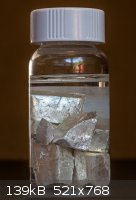nezza
Hazard to Others
  
Posts: 324
Registered: 17-4-2011
Location: UK
Member Is Offline
Mood: phosphorescent
|
|
Shiny sodium
I have recently acquired some sodium. The metal was originally coated with oxide so I have cut that off and resuspended the metal in boiled and cooled
paraffin oil under argon. there was an initial slight reaction (expected) and some bubbles of presumably hydrogen released. The metal now shows a
shiny surface. Is this a very thin oxide coating or what and have others experienced the same ?. I have attached a picture of the sodium.

|
|
|
Zan Divine
Hazard to Others
  
Posts: 170
Registered: 3-12-2011
Location: New York
Member Is Offline
Mood: Wishing all the worst that life has to offer to that SOB Wayne Lapierre
|
|
Metallic sodium is shiny, and hydroxide & oxides are not. If shiny, it's metal. So far, so good.
Enter....the diffusion leak. A diffusion leak is a leak driven not by pressure per se but by concentration. As long as the oxygen concentration in the
bottle (moisture too, for that matter) differs from that outside, a driving force exists trying to equalize that. Inside the bottle, oxygen and
moisture are consumed. The cap allows more oxygen and moisture to diffuse inward along the seal and this process never stops. Your surfaces will not
be shiny by the time fall rolls around.
He who makes a beast of himself gets rid of some of the pain of being a man. --HST
|
|
|
MrTechGuy1995
Harmless

Posts: 27
Registered: 21-9-2011
Location: Chatham, New Jersey
Member Is Offline
Mood: Lab Envy
|
|
Wait a sec, that looks a bit like potassium rather than sodium.
It's just a hunch though.
Zan is right.
If you want to keep them nice and shiny, put them in ampules.
Currently in college, studying Computer Science. Missing my home laboratory, and all the fun things I got to do. Still trying to explore the outskirts
of chemistry for curiosities sake.
|
|
|
chemrox
International Hazard
    
Posts: 2961
Registered: 18-1-2007
Location: UTM
Member Is Offline
Mood: LaGrangian
|
|
What about casting them in solid parafin? The pressure inside the casting would be negligibly low if done right. There are some liquid plastics one
might use as well; tool-dip?? The latter case might be compromised by high vapor pressure of solvents... don't know much about the stuff.
"When you let the dumbasses vote you end up with populism followed by autocracy and getting back is a bitch." Plato (sort of)
|
|
|
Endimion17
International Hazard
    
Posts: 1468
Registered: 17-7-2011
Location: shores of a solar sea
Member Is Offline
Mood: speeding through time at the rate of 1 second per second
|
|
Do not remove the hydrogencarbonate coating. Although not as good as aluminium's oxide coating which stops the oxidation, this coating slows it down
considerably. If you remove it, a new one will be built, and then you keep removing it and essentially wasting your sodium.
If you want sodium for display, you'll need to seal it in an ampoule. If you want a reagent, you don't have to bother with its looks. Simply cut the
required amount each time you need it, and store the waste cuttings into a special bottle. After few years, when it's full, you can recycle the waste
with a considerable yield.
BTW that seems like a rather small bottle. If those pieces are smaller than half of an AA battery, you should melt them into a solid piece and put
that piece in a larger bottle filled almost to the top with boiled paraffin/kerosene/whatever.
[Edited on 6-7-2012 by Endimion17]
|
|
|